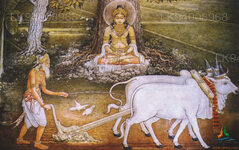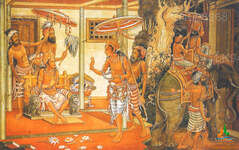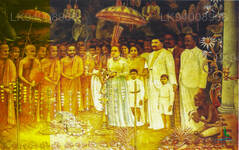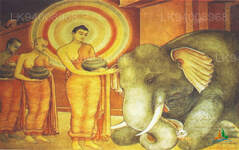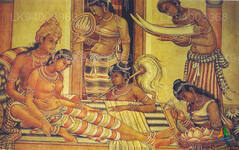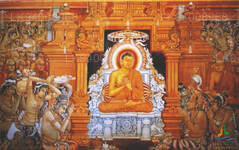
Gampaha City
Gampaha: Urban city in Sri Lanka with a mix of modern amenities and cultural heritage, including historic temples, bustling markets, and scenic landscapes.
Kelaniya Temple Paintings
It is believed that the paintings had been done with the intention of leading the people along the correct path in life. The chamber beside the old viharage contains four classic paintings which are known as Mahiyangana, Nagadeepa, Kelaniya and Padalachana. The newer section of the viharage contains paintings done by the well-known artist from Kahawa, Solius Mendis, over a period spanning 15 years.
The viharage is the only location in the country where one can see the completed work of this great artist, who was born in 1895 and passed away in 1975. Mendis changed the tradition of temple art followed up to that time, and even chose new themes for the work. Solius Mendis has contributed paintings in many Buddhist temples on the island, Meddepola Vihara, Mapitigala Malwana Purana Vihara, Jayamangala Vihara are some of the noteworthy places of them.
The painting work of Kelaniya was started in 1930 and ended in 1948. The painting of the new temple at Kelaniya Raja Maha Vihara was praised by many renowned painters in the world such as Indian artists Nandalal Boss and Joe Pikasso. Solius Mendis has improved his painting capabilities in world-renowned institutions in India and he had an opportunity to study the paintings of Ajantha, Ellora, and Sharanath during that time.
The artwork at Kelaniya depicts the history of the temple and other important events of Buddhism and follows the tradition of other Eastern countries. The old method of drawing several pictures to depict a series of happenings in the same event was done away with, and bigger pictures, taking up more space on the walls, were drawn. Some of them were actual life-size drawings. He is said to have followed his own style in drawing, after studying the paintings at Ajantha and Ellora caves in India.
Even the colours and paints used had been created by him, using the locally available natural material such as clay. Mendis is said to have created the statues in the temple too. The lines of his art are very delicate and lively and have a tri-dimensional appearance. He has followed the technique known as “Petpara” where the drawings are done on dry plaster. by using various colours in drop form, transparent shapes had been achieved. The artist had been very successful in mixing colours and there are hardly any instances of colours like blue and green being used in their pure form. The colours which are most prominent are maroon, yellow, black, white and red. It is difficult to even imagine how Mendis would have conceived of some of the shades in the temple. They are paler and more soothing to the eye. These works of art received acclaim the world over, and have been recognized for their refined elegance.
About Gampaha District
Gampaha is an urban city in Sri Lanka and is the capital of the Gampaha District in Western Province, north of Colombo. Gampaha District is separated from Colombo mainly by the Kelani River. Gampaha town is about 4km from Miriswatta on Colombo-Kandy road. Gampaha is surrounded by Yakkala, Miriswatta, Weliweriya Udugampola and Ja-Ela towns.
The name "Gampaha" in Sinhala literally means Five Villages. The five villages are known to be Ihalagama, Pahalagama, Medagama, Pattiyagama and Aluthgama.
About Western Province
The Western Province is the most densely populated province of Sri Lanka. It is home to the legislative capital Sri Jayawardenapura as well to Colombo, the nation's administrative and business center. Western Province is divided into 3 main districts called Colombo (642 km²), Gampaha (1,386.6 km²) and Kalutara (1,606 km²) districts. As Sri Lanka's economic hub, all the major local and international corporations have their presence in the city and so do all the major designer and high street retailers, so be ready to indulge in some retail therapy in western province.
Having the highest population in the all the provinces, the almost all the premier educational institutions in the island are located in western province. Universities in the province include the University of Colombo, the University of Sri Jayewardenepura, University of Kelaniya, Open University, Sri Lanka, Buddhist and Pali University of Sri Lanka, General Sir John Kotelawala Defence University and University of Moratuwa .Western province has the largest amount of schools in the country, which includes National, Provincial, Private and International schools.
【Text by Lakpura™. Images by Google, copyright(s) reserved by original authors.】

